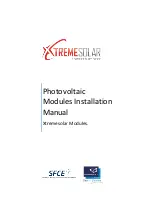
9
082809
section three
Collector Layout, Orientation, and Siting
Place the collector where it will receive the maximum amount of sunlight available in your location. OVSOL
collectors may be installed on a roof, against a south facing wall, or on the ground.
Orientation
Orientation and tilt are critical to performance. The OVSOL collectors should be oriented (faced) as close
to true south as practical, although they may be faced as much as 20° east or west of true south with less
than 5% loss in capacity. Because the earth’s magnetic field is not aligned parallel to the earth’s north-
south axis, there are some parts of the United States where the needle of a magnetic compass can point as
much as 20° east or west of true north. There are several ways to determine true south in your area. You
can consult a local surveyor, a plot map in your
local tax office, or a recent isogonic chart of the
United States published by the U.S. Coast and
Geodetic Survey. Adjust your magnetic com-
pass reading according to the meridian nearest
to you. Do not use old charts, as there are
annual variations in the readings. When using
a magnetic compass, beware of standing near
large metallic objects or power lines because
they will affect the compass readings.
Shading
Trees, chimneys, dormers, other buildings,
new construction, and even fences may shade the collector array, especially in the winter when sun angles
are low and shadows are long. Be sure the collectors are placed where they will be not shaded by these
obstructions. As a rule, no more than 5% of the collector area should be shaded between the hours of 9:00
a.m. and 3:00 p.m. It is highly advised to make use of a solar site selector while determining suitability for a
collector site.
Angle of Inclination
or
Tilt Angle
For domestic water, use an optimum tilt of the site’s latitude plus 5°, although the slope may be 10° greater
or less with a capacity loss of under 5% for the system. For a solar space heating system, a steeper tilt
angle is important for optimal winter performance. The steeper tilt will favor winter system operations when
the sun is low in the sky. Therefore, for space heating systems chose a tilt of latitude plus 15°.
The variation of 10° either way will not seriously affect the total annual performance of the system, all other
things being equal.
The following chart will help you determine the tilt angle of roof pitches. For space heating systems, always











































